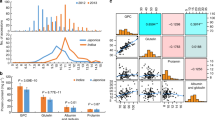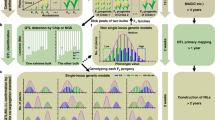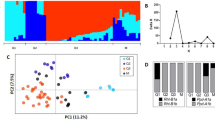Abstract
Increasing crop yield is one of the most important goals of plant science research. Grain size is a major determinant of grain yield in cereals and is a target trait for both domestication and artificial breeding1. We showed that the quantitative trait locus (QTL) GS5 in rice controls grain size by regulating grain width, filling and weight. GS5 encodes a putative serine carboxypeptidase and functions as a positive regulator of grain size, such that higher expression of GS5 is correlated with larger grain size. Sequencing of the promoter region in 51 rice accessions from a wide geographic range identified three haplotypes that seem to be associated with grain width. The results suggest that natural variation in GS5 contributes to grain size diversity in rice and may be useful in improving yield in rice and, potentially, other crops2.
This is a preview of subscription content, access via your institution
Access options
Subscribe to this journal
Receive 12 print issues and online access
$209.00 per year
only $17.42 per issue
Buy this article
- Purchase on Springer Link
- Instant access to full article PDF
Prices may be subject to local taxes which are calculated during checkout




Similar content being viewed by others
References
Xing, Y. & Zhang, Q. Genetic and molecular bases of rice yield. Annu. Rev. Plant Biol. 61, 421–442 (2010).
Zhang, Q. Strategies for developing green super rice. Proc. Natl. Acad. Sci. USA 104, 16402–16409 (2007).
Li, X. et al. Control of tillering in rice. Nature 422, 618–621 (2003).
Takeda, T. et al. The OsTB1 gene negatively regulates lateral branching in rice. Plant J. 33, 513–520 (2003).
Ashikari, M. et al. Cytokinin oxidase regulates rice grain production. Science 309, 741–745 (2005).
Xue, W. et al. Natural variation in Ghd7 is an important regulator of heading date and yield potential in rice. Nat. Genet. 40, 761–767 (2008).
Li, S. et al. Short panicle1 encodes a putative PTR family transporter and determines rice panicle size. Plant J. 58, 592–605 (2009).
Jiao, Y. et al. Regulation of OsSPL14 by OsmiR156 defines ideal plant architecture in rice. Nat. Genet. 42, 541–544 (2010).
Miura, K. et al. OsSPL14 promotes panicle branching and higher grain productivity in rice. Nat. Genet. 42, 545–549 (2010).
Wei, X. et al. DTH8 suppresses flowering in rice, influencing plant height and yield potential simultaneously. Plant Physiol. 153, 1747–1758 (2010).
Yan, W.H. et al. A major QTL, Ghd8, plays pleiotropic roles in regulating grain productivity, plant height, and heading date in Rice. Mol. Plant 4, 319–330 (2011).
Fan, C. et al. GS3, a major QTL for grain length and weight and minor QTL for grain width and thickness in rice, encodes a putative transmembrane protein. Theor. Appl. Genet. 112, 1164–1171 (2006).
Takano-Kai, N. et al. Evolutionary history of GS3, a gene conferring grain size in rice. Genetics 182, 1323–1334 (2009).
Mao, H. et al. Linking differential domain functions of the GS3 protein to natural variation of grain size in rice. Proc. Natl. Acad. Sci. USA 107, 19579–19584 (2010).
Song, X., Huang, W., Shi, M., Zhu, M. & Lin, H.A. QTL for rice grain width and weight encodes a previously unknown RING-type E3 ubiquitin ligase. Nat. Genet. 39, 623–630 (2007).
Shomura, A. et al. Deletion in a gene associated with grain size increased yields during rice domestication. Nat. Genet. 40, 1023–1028 (2008).
Weng, J. et al. Isolation and initial characterization of GW5, a major QTL associated with rice grain width and weight. Cell Res. 18, 1199–1209 (2008).
Wang, E. et al. Control of rice grain-filling and yield by a gene with a potential signature of domestication. Nat. Genet. 40, 1370–1374 (2008).
Wu, C. et al. Brassinosteroids regulate grain filling in rice. Plant Cell 20, 2130–2145 (2008).
Li, J. et al. Analyzing quantitative trait loci for yield using a vegetatively replicated F2 population from a cross between the parents of an elite rice hybrid. Theor. Appl. Genet. 101, 248–254 (2000).
Tan, Y. et al. Genetic bases of appearance quality of rice grains in Shanyou 63, an elite rice hybrid. Theor. Appl. Genet. 101, 823–829 (2000).
Xing, Y. et al. Characterization of the main effects, epistatic effects and their environmental interactions of QTLs on the genetic basis of yield traits in rice. Theor. Appl. Genet. 105, 248–257 (2002).
Yu, S. et al. Importance of epistasis as the genetic basis of heterosis in an elite rice hybrid. Proc. Natl. Acad. Sci. USA 94, 9226–9231 (1997).
Kikuchi, S. et al. Collection, mapping, and annotation of over 28,000 cDNA clones from japonica rice. Science 301, 376–379 (2003).
Liu, J., Cong, B. & Tanksley, S. Generation and analysis of an artificial gene dosage series in tomato to study the mechanisms by which the cloned quantitative trait locus fw2.2 controls fruit size. Plant Physiol. 132, 292–299 (2003).
Jeong, D. et al. Generation of flanking sequence-tag database for activation-tagging lines in japonica rice. Plant J. 45, 123–132 (2006).
Jeon, J. et al. T-DNA insertional mutagenesis for functional genomics in rice. Plant J. 22, 561–570 (2000).
Francis, D. The plant cell cycle-15 years on. New Phytol. 174, 261–278 (2007).
Inzé, D. Green light for the cell cycle. EMBO J. 24, 657–662 (2005).
Inzé, D. & De Veylder, L. Cell cycle regulation in plant development. Annu. Rev. Genet. 40, 77–105 (2006).
De Veylder, L., Beeckman, T. & Inzé, D. The ins and outs of the plant cell cycle. Nat. Rev. Mol. Cell Biol. 8, 655–665 (2007).
Dewitte, W. & Murray, J. The plant cell cycle. Annu. Rev. Plant Biol. 54, 235–264 (2003).
Frary, A. et al. fw2.2: a quantitative trait locus key to the evolution of tomato fruit size. Science 289, 85–88 (2000).
Cong, B., Liu, J. & Tanksley, S. Natural alleles at a tomato fruit size quantitative trait locus differ by heterochronic regulatory mutations. Proc. Natl. Acad. Sci. USA 99, 13606–13611 (2002).
Hiei, Y., Ohta, S., Komari, T. & Kumashiro, T. Efficient transformation of rice (Oryza sativa L.) mediated by Agrobacterium and sequence analysis of the boundaries of the T-DNA. Plant J. 6, 271–282 (1994).
Livak, K. & Schmittgen, T. Analysis of relative gene expression data using real-time quantitative PCR and the 2−ΔΔCT method. Methods 25, 402–408 (2001).
Acknowledgements
We thank J. Hu, H. Du, W. Dong and G. Gao for their help and suggestions, and G. An (Kyung Hee University, Crop Biotech Institute, Republic of Korea) for the mutant line. This work was supported by grants from the National 863 Project, the National Program on the Development of Basic Research, the National Program on R&D of Transgenic Plants, the National Natural Science Foundation of China and the Bill & Melinda Gates Foundation.
Author information
Authors and Affiliations
Contributions
Y.L. conducted most of the experiments, including fine mapping, gene cloning, genetic transformation, expression analysis, mutant analysis, histological analysis and other functional analysis; C.F., Y.X. and L.L. conducted the QTL primary mapping analysis and developed the NILs; Y.J. and L.S. carried out part of the cell division and expression analysis; D.S., C.X., X.L. and J.X. participated in the promoter sequencing; Y.H. and Q.Z. designed and supervised the study; and Y.L. and Q.Z. analyzed the data and wrote the paper. All of the authors discussed the results and commented on the manuscript.
Corresponding authors
Ethics declarations
Competing interests
The authors declare no competing financial interests.
Supplementary information
Supplementary Text and Figures
Supplementary Tables 1–10 and Supplementary Figures 1–5 (PDF 819 kb)
Rights and permissions
About this article
Cite this article
Li, Y., Fan, C., Xing, Y. et al. Natural variation in GS5 plays an important role in regulating grain size and yield in rice. Nat Genet 43, 1266–1269 (2011). https://doi.org/10.1038/ng.977
Received:
Accepted:
Published:
Issue Date:
DOI: https://doi.org/10.1038/ng.977
This article is cited by
-
Natural variation of Grain size 3 allele differentially functions in regulating grain length in xian/indica and geng/japonica rice
Euphytica (2024)
-
Identification of qGL4.1 and qGL4.2, two closely linked QTL controlling grain length in rice
Molecular Breeding (2024)
-
Fine mapping of a major QTL, qKl-1BL controlling kernel length in common wheat
Theoretical and Applied Genetics (2024)
-
Three QTL from Oryza meridionalis Could Improve Panicle Architecture in Asian Cultivated Rice
Rice (2023)
-
Multiomics comparative analysis of the maize large grain mutant tc19 identified pathways related to kernel development
BMC Genomics (2023)



